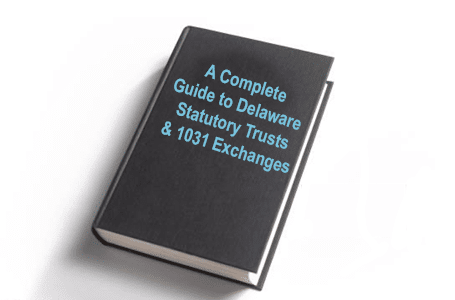- How do Delaware Statutory Trusts and 1031 exchanges work together?
- What are the rules of a 1031 exchange as outlined by the IRS?
- What are the advantages of a 1031 exchange for real estate investors?
- What is a Delaware Statutory Trust?
- What are some of the benefits of the Delaware Statutory Trust for investors?
Delaware Statutory Trusts and 1031 exchanges are the ultimate power couple of real estate investing. The two entities go hand-in-hand, dedicated to deferring capital gains taxes while also creating greater portfolio diversification*.
That’s why investors should make it a point to acquaint themselves with both DSTs and 1031 exchanges, as their union can hold the key to unlocking tax advantages and expanding investment horizons for real estate investors.
To help investors better understand both the Delaware Statutory Trusts and 1031 exchanges, Cove Capital Investments has created the Complete Guide to Delaware Statutory Trusts and 1031 Exchanges.
While both DSTs and 1031 exchanges share similar objectives, they each have their own set of rules and opportunities. Exploring the synergies between DSTs and 1031 exchanges for real estate investors can open up a powerful strategy for minimizing taxable events and simultaneously maximizing return potential.
The 1031 Exchange Explained
The 1031 exchange is rooted in Section 1031 of the Internal Revenue Code, and has served as a very unique tax-deferral strategy for real estate investors for more than 100 years.
The main purpose of the 1031 exchange is to enable investors to defer capital gains taxes upon the sale of investment properties. This provision allows investors to reinvest proceeds from the sale into “like-kind” properties in order to defer any potential taxable gains somewhere in the future. In this way, the 1031 exchange provides investors a flexible mechanism to transition from one investment property to another without incurring immediate tax consequences.
The Rules and Regulations of the 1031 Exchange
The IRS imposes strict guidelines and regulations governing 1031 exchanges. These regulations dictate the timing, nature, and structure of transactions eligible for 1031 treatment. Some of these guidelines include that in order to qualify for a 1031 exchange, the properties involved must be held for productive use in a trade or business or for investment purposes, excluding personal residences and inventory properties. The exchange must be properly structured as a simultaneous swap or a delayed exchange using a Qualified Intermediary (also known as an Accommodator).
In addition, strict time constraints apply, with investors having 45 days to identify potential replacement properties and 180 days to complete the exchange after the sale of the relinquished property.
While following these timelines and dictates can be daunting, the benefits of 1031 exchanges can make the extra stress worth it. For example, even beyond the tax deferral benefits, 1031 exchanges help investors accomplish the following;- Protect capital from taxation which can be used for reinvestment
- Accelerate wealth accumulation potential
- Facilitate generational wealth transfer and estate planning
- Improve potential diversification of real estate holdings*
These benefits underscore the importance of incorporating 1031 exchanges into a comprehensive real estate investment strategy aimed the goal of maximizing long-term returns and minimizing tax burdens.
An Introduction to Delaware Statutory Trusts
100% Passive Investment
Unlike traditional ownership structures, DSTs allow investors to hold “beneficial ownership” interests in large commercial grade properties without assuming direct management responsibilities. In addition, behind every DST property is a real estate sponsor company that oversees the acquisition, management, and disposition of real estate assets within the trust on behalf of investors.
In this way, Delaware Statutory Trusts allow investors to not only enter a purely passive management structure, but also access larger real estate assets than they might otherwise be able to.
Pre-Packaged for 1031 Exchanges
Non-Recourse Financing
Another aspect of DSTs is that the financing used on the properties is typically non-recourse to the investor. Non-recourse financing is typically defined as financing whereby the lender’s only remedy in the case of a default is the subject property itself. In other words, the lender is not able to pursue the investor’s other assets beyond the subject property. So, while investors could lose their entire principal amount invested in the DST property should there be a major tenant bankruptcy, market- wide recession or even depression, but their other assets would be protected from a lender.
The non-recourse financing used on DST 1031 properties is also typically long- term (usually seven to 10 years) and already locked and in place with the lender. This can greatly help to reduce 1031 exchange closing risk for investors that must be able to identify a property within their 45-day identification period that they know that are going to be able to close on.
Synergies Between DSTs and 1031 Exchanges: DSTs and 1031 exchanges intersect as strategic vehicles for tax-deferred real estate investment. By utilizing DSTs within 1031 exchange transactions, investors can defer capital gains taxes upon the sale of relinquished properties while gaining access to professionally managed real estate and DST portfolios. The passive nature of DST investments aligns with the objectives of 1031 exchanges, allowing investors to transition from active management to a more hands-off approach while maintaining tax deferral benefits.


